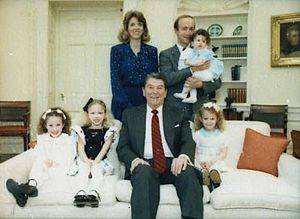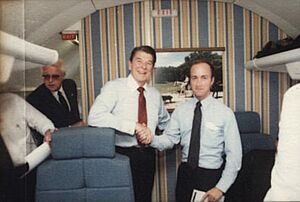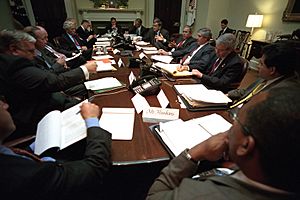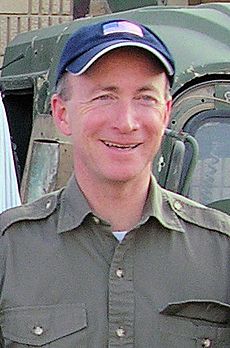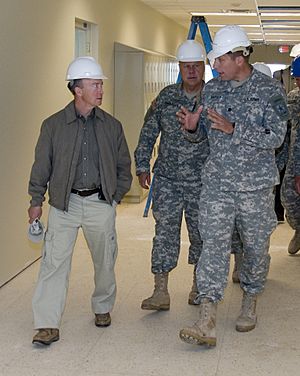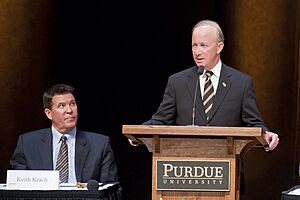Mitch Daniels facts for kids
Quick facts for kids
Mitch Daniels
|
|
|---|---|
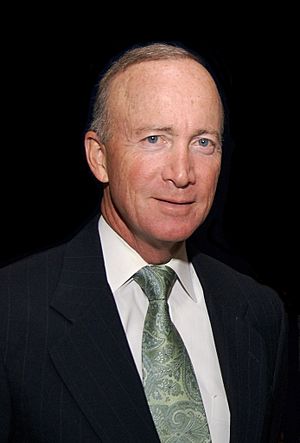
Daniels in 2009
|
|
| 12th President of the Purdue University System | |
| In office January 14, 2013 – December 31, 2022 |
|
| Preceded by | France Cordova Timothy Sands (acting) |
| Succeeded by | Mung Chiang |
| 49th Governor of Indiana | |
| In office January 10, 2005 – January 14, 2013 |
|
| Lieutenant | Becky Skillman |
| Preceded by | Joe Kernan |
| Succeeded by | Mike Pence |
| 33rd Director of the Office of Management and Budget | |
| In office January 20, 2001 – June 6, 2003 |
|
| President | George W. Bush |
| Deputy | Sean O'Keefe Nancy P. Dorn |
| Preceded by | Jack Lew |
| Succeeded by | Joshua Bolten |
| White House Director of Political and Intergovernmental Affairs | |
| In office October 1, 1985 – March 1, 1987 |
|
| President | Ronald Reagan |
| Preceded by | Ed Rollins |
| Succeeded by | Frank Donatelli |
| Director of the White House Office of Intergovernmental Affairs | |
| In office March 26, 1985 – October 1, 1985 |
|
| President | Ronald Reagan |
| Preceded by | Lee Verstandig |
| Succeeded by | Deborah Steelman |
| Personal details | |
| Born |
Mitchell Elias Daniels Jr
April 7, 1949 Monongahela, Pennsylvania, U.S. |
| Political party | Republican |
| Spouses |
Cheri Herman
(m. 1978; div. 1993)
(m. 1997) |
| Children | 4 |
| Education | Princeton University (BA) Georgetown University (JD) |
| Signature | |
Mitchell Elias Daniels Jr. (born April 7, 1949) is an American academic leader, businessman, and former politician. He served as the 49th governor of Indiana from 2005 to 2013. A Republican, he later became the president of Purdue University. He held this role from January 2013 until the end of 2022.
Daniels started his career helping Senator Richard Lugar. He was Lugar's chief of staff in the Senate from 1977 to 1982. He also led the National Republican Senatorial Committee when Lugar was chairman. In 1985, he advised President Ronald Reagan. Later, he worked at Eli Lilly and Company, a large pharmaceutical company. In 2001, President George W. Bush chose Daniels to lead the U.S. Office of Management and Budget. He worked there until 2003.
Daniels ran for governor of Indiana in 2004. He won the election and was reelected in 2008. As governor, he focused on cutting government costs and balancing the state budget. After his time as governor, he became president of Purdue University.
Contents
Early Life and Education
Mitchell Elias Daniels Jr. was born on April 7, 1949, in Monongahela, Pennsylvania. His family moved to Indiana in 1959. He attended North Central High School and was student body president. In 1967, he was named one of Indiana's top high school graduates.
In 1971, Daniels earned a bachelor's degree from Princeton University. He later studied law at the Georgetown University Law Center. He earned his law degree there.
Early Political Career
Daniels first worked in politics as a teenager in 1968. He helped with a U.S. Senate campaign. He then interned for Indianapolis mayor Richard Lugar. Daniels worked on Lugar's campaigns and joined his mayoral staff. When Lugar was elected to the U.S. Senate in 1976, Daniels became his Chief of Staff in Washington, D.C.. He served in this role during Lugar's first term, from 1977 to 1982.
Personal Life
Daniels met Cheri Herman while working with Senator Lugar. They married in 1978 and had four daughters. They divorced in 1993 but remarried in 1997.
Working in Washington, D.C.
In 1983, Daniels became the executive director of the National Republican Senatorial Committee. This group helps elect Republicans to the Senate. He helped the GOP keep control of the Senate. In 1985, Daniels became a chief political advisor to President Ronald Reagan. He also worked as a link to state and local governments.
Return to Indiana
In 1987, Daniels moved back to Indiana. He became president and CEO of the Hudson Institute, a research group. In 1990, Daniels joined Eli Lilly and Company, a large pharmaceutical company. He became President of North American Operations in 1993. Later, he was Senior Vice President for Corporate Strategy and Policy until 2001.
During his time at Eli Lilly, the company grew a lot. Its assets and revenue doubled.
Leading the Office of Management and Budget
On December 22, 2000, President-elect George W. Bush announced that Daniels would lead the Office of Management and Budget (OMB). The United States Senate approved his nomination in January 2001. In this role, Daniels was also part of the National Security Council.
As OMB director, Daniels tried to limit government spending. He wanted to cut costs in many agencies. During his 29 months in this role, the projected federal budget surplus turned into a deficit. This was due to a recession, tax cuts, and wars in Afghanistan and Iraq. Daniels resigned in May 2003 to prepare to run for governor of Indiana.
Governor of Indiana (2005–2013)
Election Campaign
Daniels decided to run for Governor of Indiana in 2004. He won the Republican primary election. He then defeated the current Democratic Governor Joe Kernan in the general election. Daniels traveled to all 92 counties in Indiana multiple times. He used a recreational vehicle (RV) nicknamed "RV-1" for his campaign. He won the election with about 53% of the votes. Kernan was the first sitting governor in Indiana to lose an election since 1892.
First Term as Governor
On his first day as governor, Daniels created Indiana's first Office of Management and Budget. This office looked for ways to save money in state government. He also ended the requirement for state employees to pay union dues.
Budget Management
Daniels worked to improve Indiana's financial situation. The state had a projected budget shortfall. He called for strict controls on spending. He also renegotiated state contracts, saving millions of dollars. These actions helped turn a deficit into a budget surplus. The state also restored funds to local governments and schools.
Daylight Saving Time
One big change Daniels supported was Indiana adopting Daylight Saving Time. Before this, parts of the state observed different times, causing confusion. Daniels argued it was needed for the economy. In April 2005, the General Assembly voted to adopt Eastern Daylight Saving Time for most of the state.
Highway Improvements
In 2006, Daniels introduced a plan to improve state highways. This plan, called Major Moves, involved leasing the Indiana Toll Road. The road was leased for 75 years for a payment of $3.85 billion. The company also promised to make $4.4 billion in upgrades.
Daniels said the road was not making money for the state. The money from the lease was used to fund many transportation projects. It also created a trust fund for highway maintenance. This allowed Indiana to improve roads and bridges without new taxes or debt.
Healthy Indiana Plan
In 2007, Daniels signed the Healthy Indiana Plan. This program helped 132,000 uninsured workers get health coverage. It helped people buy private health insurance with state help. The plan encouraged health screenings and prevention. It was funded by an increase in the state's cigarette tax.
Property Tax Reform
In 2008, Daniels proposed a limit on property taxes. This plan set a one percent cap on residential property taxes. The General Assembly approved it, and Daniels signed it into law. This led to an average property tax cut for homeowners. To make up for lost local government money, the state raised the sales tax from 6% to 7%. In 2010, voters approved adding these tax limits to the state constitution.
Voter ID Law
In 2005, Indiana passed a law requiring voters to show a government-issued photo ID. This was the first law of its kind in the U.S. The state offered free ID cards to those who needed them. The United States Supreme Court upheld this law in 2008.
Reelection Campaign
Daniels ran for reelection in 2008. His campaign focused on the state's lower unemployment rate and balanced budget. He also highlighted the proposed property tax reform. On November 4, 2008, Daniels defeated Democratic candidate Jill Long Thompson. He won a second term as governor with 57.8% of the votes. He received more votes than any candidate in Indiana's history.
Second Term as Governor
In 2010, Republicans gained control of both houses of the General Assembly. This allowed Daniels to pursue more of his agenda.
Education Reforms
Daniels signed several education reform laws. A statewide school voucher program was created. This program helped children from lower-income families attend private schools. The law also created a merit pay system for teachers. It gave school leaders more power to manage teachers. It also changed collective bargaining rights for teachers.
Economy and Job Growth
Raising incomes for Hoosiers was a key goal for Daniels. While some critics point to changes in per capita income, supporters argue Indiana recovered from the Great Recession faster than the rest of the nation. This was seen in job growth and consumer spending.
Right to Work Law
Indiana became the first state in a decade to pass a Right to Work law. This law makes it illegal to require employees to join a union. Daniels signed the law on February 1, 2012. Many manufacturing companies have said this law was important in their decision to move to Indiana.
Presidential Speculation
Many people thought Daniels might run for president in 2012. Media outlets discussed his record of reforming government and balancing budgets. Daniels said he was open to the idea in 2010. However, on May 21, 2011, Daniels announced he would not seek the Republican nomination. He cited family reasons and the loss of privacy.
President of Purdue University
As Daniels' second term as governor ended, he was recommended to become the 12th president of Purdue University. The Purdue Board of Trustees elected him unanimously in June 2012. His term began in January 2013. Daniels focused on making higher education more affordable and improving academic excellence.
Student Focus
Daniels often said his top priority was students. He worked out at the student gym and ate with students. He even made a viral music video with engineering students. At football games, he would sit with fans, sometimes in the student section.
Purdue Polytechnic Indianapolis High School
In 2015, Daniels announced plans for the Purdue Polytechnic Indianapolis high school. This school was designed to help inner-city students prepare for Purdue. It aims to increase the number of low-income and minority students attending the university.
Racial Equity and Campus Climate
Daniels has faced criticism from some student groups and faculty regarding racial issues on campus. In 2016, racist posters appeared. Daniels called them a "transparent effort to bait people" and said their views were against Purdue's values. In 2019, he apologized for a phrase he used about African American scholars. In 2020, he supported a task force to address racial inequality. Purdue has also worked to protect free speech on campus.
Tuition Freezes and Cost Reductions
Before Daniels, Purdue's tuition increased every year since 1976. Two months after he became president, Purdue froze tuition for two years. This freeze was extended for ten years, through 2023. This meant many students graduated without a tuition increase. Student borrowing decreased, and the university claims families saved over a billion dollars. Daniels also reduced meal plan rates and froze housing costs.
Purdue Moves Initiatives
In 2013, Daniels announced "Purdue Moves." This plan focused on affordability and new investments. It included hiring more faculty in STEM (Science, Technology, Engineering, and Math). It also aimed to expand research and create new degree programs. Under Daniels, Purdue increased its number of start-up companies and patents.
Response to COVID-19
In April 2020, Daniels announced Purdue would welcome students back to campus in the fall. He said it was important to reopen. Purdue launched the "Protect Purdue" plan. This plan used masking, contact tracing, and facility changes to keep the campus safe. The university conducted many COVID tests throughout the academic year.
Acquisition of Kaplan and Purdue Global
In 2017, Purdue announced it would acquire Kaplan University. This was to create an online university called Purdue University Global. The goal was to expand access to online education. The acquisition received both praise and criticism. Some faculty members expressed concerns. However, enrollment at Purdue Global has grown since its launch.
End of Presidency
Daniels was replaced by Dr. Mung Chiang as President of Purdue University on January 1, 2023. After leaving Purdue, Daniels considered running for the U.S. Senate but decided against it. He said it was not the right job or life for him. One month after he left, Purdue's business school was named the Mitchell E. Daniels, Jr. School of Business.
Honors
- Woodrow Wilson Award, Princeton University (2013)
- Bradley Prize, Bradley Foundation (2013)
- Order of the Rising Sun, 2nd Class, Gold and Silver Star (2017)
- World's Greatest Leaders, No. 41 Fortune Magazine (2015)
- Gerald R. Ford Medal for Distinguished Public Service, Gerald R. Ford Presidential Foundation (2024)
- Theodore Roosevelt Distinguished Service Medal, Theodore Roosevelt Association (2024)
Images for kids
See also
 In Spanish: Mitch Daniels para niños
In Spanish: Mitch Daniels para niños


